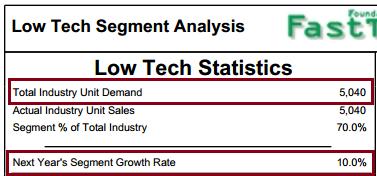Calculating Market Demand The Industry Demand Analysis will help the Marketing and Production Departments understand future demand. Marketing can use the total demand for each
Calculating Market Demand
The Industry Demand Analysis will help the Marketing and Production Departments understand future demand. Marketing can use the total demand for each segment as it creates a sales forecast. Production can use the results when making capacity buy and sell decisions.You will need:
The Segment Analysis reports (pages 5-6) of the Foundation FastTrack for Round 0
The Industry Conditions Report.
At the top of each Segment Analysis page you will find each segment?s statistics (see example below). The top line is the total demand for the segment for last year (the FastTrack reports last year's data). The fourth line tells you next years growth rate for the segment. To find out the coming years total demand, simply apply the growth rate to last years total demand.

* The above growth and demand figures are for example only. Your industry growth rates and demand may differ, but the process to calculate next years total segment demand is identical.
For example, in the Low Tech segment analysis on the left, Total Demand is 5040 and next years growth rate is 10.0%. Next years demand is calculated as follows:
| Total demand | 5040 |
| + | |
| Growth (Total Demand x 10.0%) | 504 |
| Total Segment Demand next year (rounded to nearest whole number) | 5544 |
Industry Demand Activity
For your purposes, complete the form below with the "average" scenario. Assume the Round 1 growth rates will continue into the future unchanged. This will give you some idea for potential market size. If you have time, try a worst case and best case scenario for Rounds 2 through 8. For worst case, assume, say, half the growth rate. For best case assume, say, 1.5 times the growth rate.
Use the information in the FastTrack to calculate the Round 1 demand for each of the segments. Once you have successfully entered the correct demand for Rounds 0 and 1, then the rest of the table will fill automatically.Incomplete
| Low Tech | ||
|---|---|---|
| Rnd | Demand | Rate (%) |
| 0 | ||
| 1 | ||
| 2 | ||
| 3 | ||
| 4 | ||
| 5 | ||
| 6 | ||
| 7 | ||
| 8 | ||
| High Tech | ||
|---|---|---|
| Rnd | Demand | Rate (%) |
| 0 | ||
| 1 | ||
| 2 | ||
| 3 | ||
| 4 | ||
| 5 | ||
| 6 | ||
| 7 | ||
| 8 | ||
The Round 0 Foundation FastTrack
While you can calculate the demand for Round 1 from the information on hand, future growth rates are unknown. Can you predict the market size for Rounds 2 to 8? No. On the other hand, you need something for planning purposes to address critical questions like:
How much production capacity will we need in the future? How much money do we need to raise? Which segments are most attractive for investment?
Planners address this type of issue with scenarios. Typically there are three: worst case, average case, and best case. The average case assumes that the current growth continues indefinitely into the future.
Worst case assumes a lower growth rate. Best case a higher growth rate. The truth will unfold as the simulation progresses. Next year's growth rate is published in the Foundation FastTrack on each Segment page in the Statistics Box.
Low Tech Segment Analysis Low Tech Statistics Total Industry Unit Demand Actual Industry Unit Sales Segment % of Total Industry FastT Next Year's Segment Growth Rate 5,040 5,040 70.0% 10.0%
Step by Step Solution
3.51 Rating (175 Votes )
There are 3 Steps involved in it
Step: 1
To calculate the Round 1 demand for each segment we will use the given growth rates and the total de...
See step-by-step solutions with expert insights and AI powered tools for academic success
Step: 2

Step: 3

Ace Your Homework with AI
Get the answers you need in no time with our AI-driven, step-by-step assistance
Get Started


